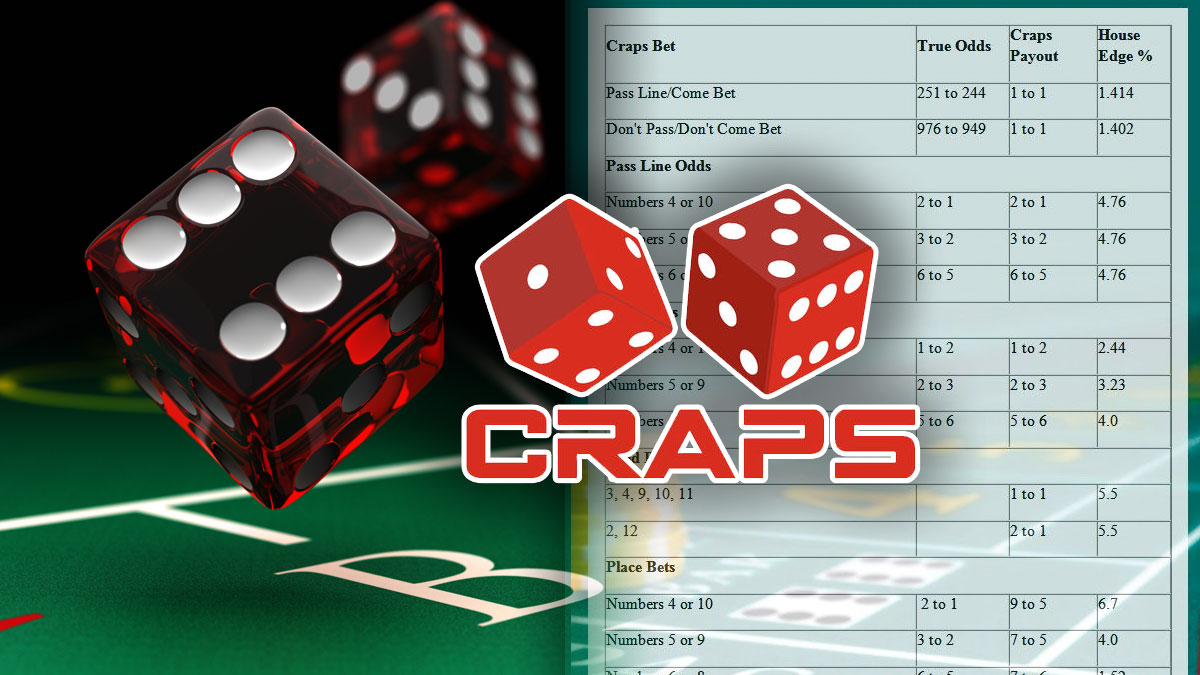Craps is one of my favorite games to write about because the numbers and odds are so interesting. I tend to focus more on the pass, don’t pass, come, don’t come, and free odds bets than anything else. After all, those are the bets that offer you the best odds of beating the casino.
I won’t stray too far from that strategy in this post about craps numbers and odds.
Once you understand the numbers – even a little bit – in craps, you won’t want to make the bad bets anymore anyway.
The Odds of Winning a Pass Line Bet on the Come-Out Roll
I always suggest betting on the pass line for beginners. This is the basic bet on craps, a bet that the shooter will succeed by either winning the come-out roll or making the point.
If you want to understand the probability of winning the pass line bet, you must account for both of those possibilities as well as the possibilities of not winning.
Let’s start with the probability of winning on the come-out roll. An event’s probability is the number of ways it can happen divided by the total number of possible events.
When you roll 2 dice, you have 36 possible outcomes: 1, 1; 1, 2; 1, 3; and so on through 6, 6. (Those are the numbers on the dice.)
You win the pass line bet on the come-out roll when you roll a 7 or an 11.
The probability of rolling a 7 is 6/36. You have 6 possible ways of making a total of 6 when rolling 2 dice, as follow:
- 1, 6
- 2, 5
- 3, 4
- 4, 3
- 5, 2
- 6, 1
The probability of rolling an 11 isn’t as good. You only have 2 ways of rolling an 11, so that probability is 2/36. Here are the ways you can roll an 11:
- 5, 6
- 6, 5
To calculate the probability of rolling a 7 or an 11, you add those 2 probabilities together:
6/36 + 2/36 = 8/36
That can be converted to a percentage easily enough, and it might be easier to conceptualize in that form. The percentage probability of winning the pass line bet on the come-out roll is 22.22%.
The Odds of Winning a Pass Line Bet by Making a Point
Calculating the probability of winning a pass line bet by making the point is more complicated. You need to account for the probability of establishing that point AND the probability of rolling the point again – “passing the point.”
Here are the probabilities of establishing each possible point:
- 4 – 3/36
- 5 – 4/36
- 6 – 5/36
- 8 – 5/36
- 9 – 4/36
- 10 – 3/36
And here are the probabilities of rolling that point number again before rolling a 7:
- 4 – 1/3
- 5 – 2/5
- 6 – 5/11
- 8 – 5/11
- 9 – 2/5
- 10 – 1/3
So, your probability for making each point is the probability of establishing the point multiplied by the probability of passing the point.
For example, the probability of setting the point at 4 and then passing the point is 3/36 X 1/3, or 3/108.
Here are the probabilities of both happening for each point total:
- 4 – 3/108
- 5 – 8/180
- 6- 25/396
- 7 – 25/396
- 8 – 8/180
- 9 – 3/108
Now that you have these 2 pieces of data – the probability of winning on the come-out roll and the probability of winning by passing the point – you can calculate the probability of winning the pass line bet.
The Overall Probability of Winning the Pass Line Bet in Craps
The overall probability of winning the pass line bet in craps is just the probability of winning on the come-out roll added to the probability of winning by establishing and making the point.
- The probability of winning on the come-out roll, as we’ve already established, is 6/36 + 2/36, or 8/36, 0.2222.
- The probability of winning by establishing and making the point is 3/108 + 8/180 + 25/396 + 25/396 + 8/180 + 3/108, or 0.2707.
Adding 0.2222 to 0.2707 gives us 0.4929, which is the same thing as 49.29%.
As you can see, the odds of winning the pass line are almost even – almost 50%.
Calculating the Probability of Losing the Pass Line Bet in Craps
You could redo all the same calculations for the other side of the equation if you wanted to – calculating the probability of rolling a 2, 3, or 12 on the come-out roll or the probability of setting a point and then rolling a 7 before rolling the point. You could add those all up and get the probability of losing.
But one of the fun thing about probabilities is that they always add up to 100%.
If you add the probability of winning to the probability of losing in craps, the total has to be 100%.
So, if the probability of winning the pass line is 49.29%, the probability of losing is just 100% – 49.29%, or 50.71%.
How Do You Calculate the House Edge for the Pass Line Bet in Craps
The house edge is the percentage of each bet that the casino expects to win in the long run — on average — per bet. It’s a long-term prediction, so, in the short term, it won’t hold true.
The easiest way to calculate the house edge is to subtract the probability of winning from the probability of losing.
In this cases, you’re looking at 50.71% – 49.29%, which is 1.41%.
This is actually one of the best house edge figures in the casino. You can find some blackjack and video poker games with a better house edge.
But I don’t think either of those games are as fun as a game of craps.
For the money, you get more entertainment playing real money craps than any of the other games in the casino.
And, if you combine the free odds bet with the pass line bet, the house edge gets even lower.
Here’s why:
Accounting for the Free Odds Bet When Looking at the House Edge in Craps
The free odds bet is a bet you can only place after making the pass line bet. It’s often also called just “the odds” bet. It’s a bet that the shooter will roll the point number before rolling a 7. The odds are easy to calculate – you just look at the number of ways you can make a point versus the number of ways you can make a 7.
The thing about the odds bet is that it has no house edge. It pays off at the same odds you have of winning it.
Here’s a list of the probabilities and payouts for each point total when making an odds bet:
- 4 or 10 – 2 to 1
- 5 or 9 – 3 to 2
- 6 or 8 – 6 to 5
Now, let’s look at what happens when you place a double odds bet – an odds bet that is twice the same as your pass line bet.
You’re a $10 bettor, so you bet $10, and the shooter rolls a 4. You take double odds, which means you put down $20 more on the odds. The shooter makes the point.
The original pass line bet pays off at even money, so you win $10 on it.
But the odds bet pays off at 2 to 1 odds – the same as the odds of making it – so you win $40 on the odds bet.
Your total winnings are $50.
The House Edge in Craps Relates to the Total Amount You Have in Action
The house edge is normally calculated as the amount you’re expected to lose relative to the amount of money you have in action.
When you have an even-money bet like the odds bet, you don’t expect to lose (or win) anything in the long run. It’s a break-even bet.
So, you’re able to put more money into action while having the same expected loss.
This has the effect of reducing the house edge on the total amount of money you have in action based on how much money you bet on the odds bet.
Here’s what the house edge on your total wager looks like when you account for the odds bet based on how big an odds bet you make. I’ve expressed the size of your odds bet as a multiple of your original pass line bet:
- 1X odds – 0.85%
- 2X odds – 0.61%
- 3X odds – 0.47%
- 5X odds – 0.33%
- 10X odds – 0.18%
- 20X odds – 0.10%
- 100X odds – 0.02%
Casinos and online casino sites generally limit how much money they allow you to put on the odds bet. Obviously, the bigger the limit, the better off you are from a house edge perspective.
Conclusion
Those are just some thoughts about the odds and probabilities in craps that might affect your thinking about the game.
Maybe the most important piece of information is the house edge as it relates to total action when taking the odds bet.
Regardless, if you do nothing but make the pass line bet and take the maximum odds, you’ll be facing one of the best games in the casino, mathematically.
Michael Stevens
Michael Stevens has been researching and writing topics involving the gambling industry for well over a decade now and is considered an expert on all things casino and sports betting. Michael has been writing for GamblingSites.org since early 2016. …



